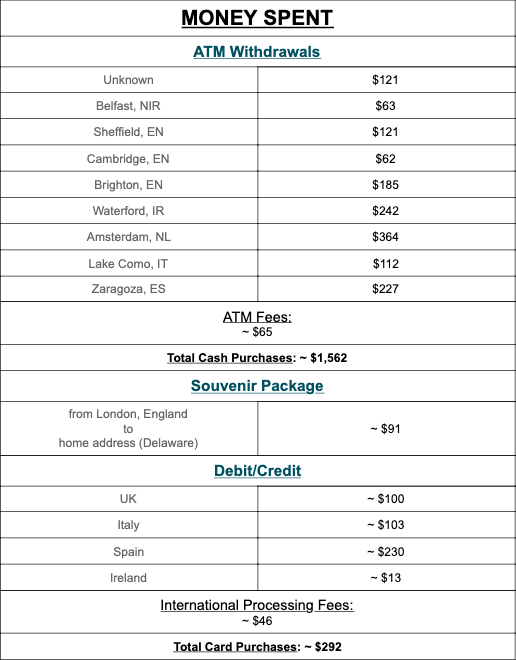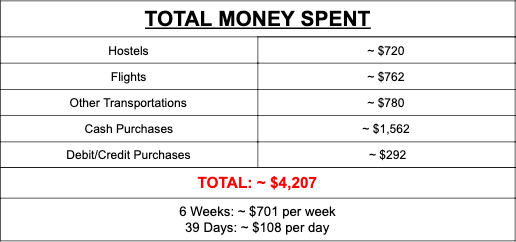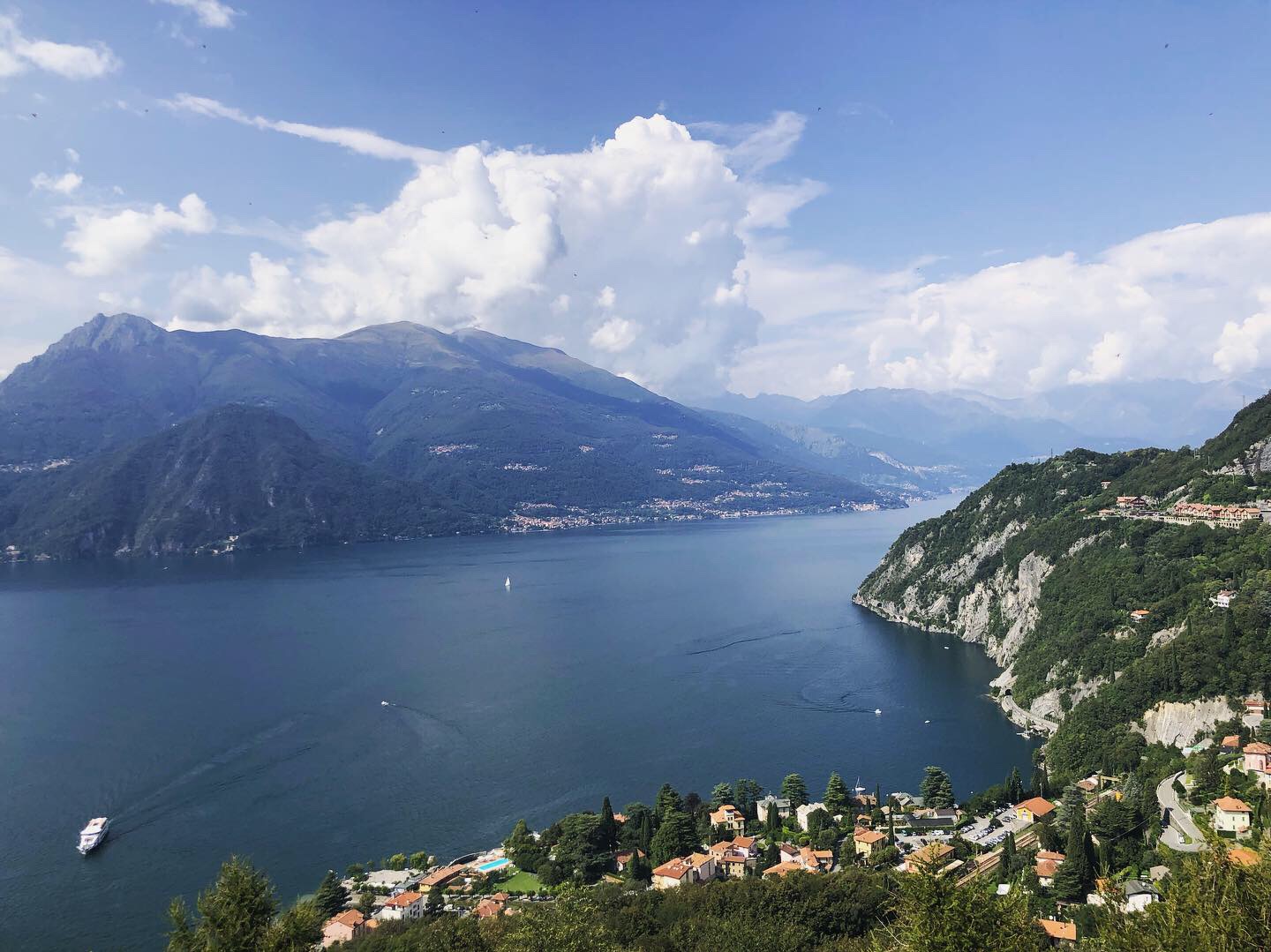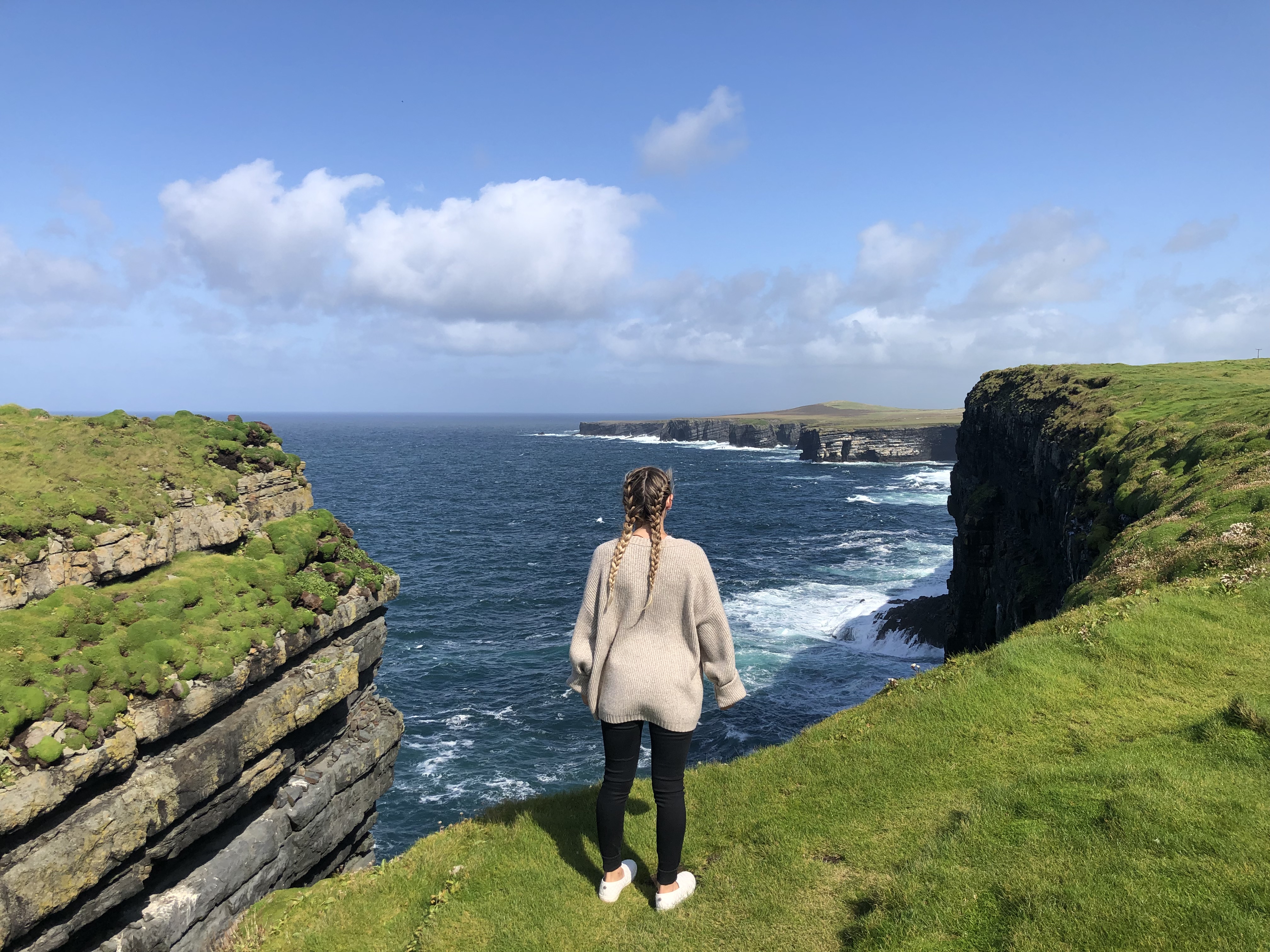What, where, when, and how money gets spent while on a trip looks different for every person.
Where are you planning to go? Popular cities are going to have higher prices in all aspects.
When are you traveling? Expenses go up during peak seasons.
What are you planning on doing? Museums, galleries, tour groups, bars, concerts, festivals, and other activities will quickly drive up daily costs.
How will you get from place to place? Flying is a good option for long distances, but tac on extra fees for baggage, liquid products, cancellations, etc. Metro, bus, train, and ferry costs vary with cities and distances. Transportation can change often; trains may be delayed, buses could run late, accidents happen. This means you’ll need a new ticket.
What will you eat? Do you plan to cook most of your meals or eat out? How often do you eat? Are you a breakfast, lunch, and dinner type of person? How much do you eat; are you a big eater or you get full easily?
Will you get travel insurance? Think about emergencies or unexpected situations. Items might get lost or stolen. Medical fees could come up, even small ones such as bandaids.
Where Are You Planning to Go?
Here’s a list of all the places I traveled to on my trip:
Dublin, Ireland
Waterford, Ireland
Kilbaha, Ireland
Cambridge, England
Brighton, England
Interlaken, Switzerland
Lake Como, Italy
(Menaggio, Bellagio, Vienna)
Belfast, Northern Ireland
London, England
Sheffield, England
York, England
Amsterdam, Netherlands
Paris, France
Barcelona, Spain
Zaragoza, Spain
Here are some cities that I had stops/layovers in, but didn’t necessarily stay in:
Birmingham, England
Lugano, Switzerland
Leeds, England
Frankfurt, Germany
You can read how I planned which country and city I would go to in my “Backpacking Europe: How I Planned It Out” post.
Where Are You Staying in Each City?
On my journey, I spent some of my trip in hostels, while other parts I stayed with friends. This effected my total spending on accommodation.
Cities I stayed in hostels:
London, England
Brighton, England
Amsterdam, Netherlands
Interlaken, Switzerland
Lake Como, Italy
Paris, France
Barcelona, Spain
Cities I stayed with friends:
All of Ireland and Northern Ireland
Sheffield, England
London, England
Cambridge, England
Barcelona, Spain
Because I was staying with friends for half of my trip (and since they are the best – not paying for accommodation those nights) I was able to splurge a little more on hostels.
As you can see, I stayed in some of the most popular cities within Western Europe.
As a result, the price I paid for some hostels were on the higher side.

Here is the list of hostels I stayed in, where they were located, the dates in which I stayed, and the “general” overall price I paid.
In total, I spent about $720 throughout the 19 nights I needed for accommodation.
This averages to about $42 a night. You could definitely do it cheaper!
As I said before, since I stayed in high-volume cities and I had an emphasis on certain wants/needs (particularly with location), my hostels generally were more on the expensive side per night.
How Are You Traveling To/Fro and Around Western Europe?
Some travel expenses you’ll know off the bat and upfront. This includes your flight in and out of the continent, maybe some flights within Europe, and/or your Eurail pass.
Other expenses you won’t know, or can’t predict, along your travels. This includes bus fees, seat reservations, smaller train routes, ferry rides, or metro passes.
For instance; if I had planned to walk from my station to my hostel, but ended up in the city late at night, I might have opted to get a bus ride instead. A specific circumstance was during my time in Italy. Until I had arrived at my hostel I hadn’t realized “Lake Como” wasn’t just a single place next to a lake, but a collection of cities around the lake. To see the other cities, I had to buy a ferry ticket to different ports each day. This wasn’t an issue for me, since I wanted to see the other cities, but it was a transportation cost I wasn’t expecting.

To the right are my flight expenses.
Below are my other transportation expenses.
This was all the transportation I was able to find and keep track of two years later. There may be some missed.
EURail PRO TIP:
My EURail cost $364 for 10 days of travel. This was an average of ~ $36 per train.
But I definitely took more than 10 train rides during my trip. So how did I decide when to use my pass and when not to?
First off, some smaller train stations don’t even validate the pass, so I had to buy a ticket anyway. For trains that did except the pass, however, I only used the EURail pass for long-distance travel that cost more than $36 (excluding seat reservation fee).
If I wanted to take a train and the ticket was only $20, I bought the ticket instead! This way, I was able to maximize my EURail ticket and essentially organized it so that the pass paid for itself.
Here’s an example:
If I didn’t buy the EURail pass and I went on ten trains where all the tickets cost $45, I would have spent $450 on train travel. But by buying the pass and using it on trains where the price was over my “average amount” ($36), I was able to save $86 on transportation costs!
Remember, this excludes seat reservations. Whether you use the pass or buy the actual ticket, the seat reservation fee is not included.
Transportation is not only about money, but time as well.
Flights may seem faster and can be at times, but you also need to think about getting to the airport, being there 1-2 hours early, security lines, boarding time, de-boarding time, possible luggage claim time, etc.
Some long-distance train travel offers over-night trains, this can allow you to spend longer time enjoying the sites of the city, verses occupying that time on the road/tracks.
While traveling from London to Dublin, I had the option of buying a flight. However, my backpack was too large at the time and wouldn’t be considered a carry-on, not to mention the price and timing of the flight itself, so I chose to go the cheaper (more interesting) route and took a bus.
This was a bus that boarded in Birmingham, UK, drove onto a cruise ship type vessel at Holyhead Ferry Terminal, sailed across the Irish Sea, and then released at Dublin Ferry Port. The entire journey took around 10 hours overnight, was a bit confusing and scary at times, but without a doubt one of the most interesting ways I got from one place to the other.
The ticket had cost ~$25.
Since all this happened overnight and the journey was quite entertaining, I without a doubt preferred it over flying.
When figuring out how you will get from point A to point B, be thorough in your research!
Check all flights, buses, and even ferries to get the best deal! Way out the pros and cons of price, time, and honestly headache, to determine what is best for you for your circumstances.
I’ve said it before but the app Rome2Rio is an essential resource when trying to find the best mode of transportation.
Remember you don’t need to figure this all out while you’re still at home! It’s completely possible, and maybe even a little easier, to play it day by day while on the road!

This map to the left shows the course of travel throughout my trip.
Plane
Train
Bus
Car
How Will You Pay for Things While Traveling?
So how you will access your money while in a foreign country is an important step to determine before you leave for your trip.
Call your credit card and debit card providers and ask about their foreign transaction fees.
Let them know that you will be in x, y, and z countries during which dates so that they don’t cut you off thinking it’s fraud.
Research different credit card providers and learn about their travel plans. Maybe it’s worth switching, or adding, companies.
Research how accessible your company is with other countries transaction systems.
I have an account with PNC Bank and I use Discover as my credit card company.
When I called them, I learned that PNC has a $5 ATM withdrawal fee and a 3% international processing fee on debit card purchases. Discover, however, took the international price and directly converted it to US dollars. So before I left, I decided to use my Discover card as my main source of payment.
Fast forward to being in Europe and I quickly realized that most places (whether food, retail, or attraction) did not accept my Discover card. I would always try to use it first, and in a few areas it worked, but 8/10 times it didn’t.
And since I wasn’t crazy about walking around every day and night with my debit card on me (as it’s a direct link to my bank account), this resulted in me visiting an ATM once a week.
I’d get between 100-250 in the currency needed (euros, franks, pounds), put a small amount in my wallet for that day, and kept the rest with my debit card, passport, and ID’s locked up safe in my backpack in the hostel.
As a result, I spent a little over $100 in ATM and international processing fees.
Maybe if I had done more research before my trip, some of this could have been avoided.
How Much Money Will You Spend While on The Road?
Museums, festivals, cafes, restaurants, bars, pharmacy needs, laundry coins, shower products, clothes, souvenirs, and more are daily expenses that you acquire while traveling.
This is all subject to you as an individual, your wants and needs, and what you’re willing to buy or put back on the shelf.
Since I was staying with friends some nights, I used that money for a nicer hostel.
Since I didn’t buy any museum or festival tickets while abroad, I used that money to go out at night.
Since I kept all my meals small and cheap, I used that money for clothes and souvenirs.
Three days into my trip I wore heels to go out one night. This resulted in a blister on the side of my pinky toe that grew and became painful. I had to buy bandaids, ointment, and disinfectant spray at a pharmacy in Amsterdam.
Boom, $20 that could have gone to a nice meal.
When boarding a flight from Belfast to Leeds, I neglected to check how much liquid I could carry in my backpack. Upon security check, I had to throw out some of my shower supplies, which meant I had to buy more when I landed.
Boom, another $10-$20.

Here’s a general overview of the money spent during my trip.
*The “souvenir package” was a box I shipped back home full of clothes I didn’t end up needing as well as souvenirs for my friends and family. This allowed me to continue using my backpack as a carry-on while giving my body a rest from the heavy bag. Definitely worth the $91*
Backpacking Western Europe: Total Cost Breakdown
You can plan, you can budget, but ultimately you won’t know how much money you spent until after you get home and check your bank account for that final number.

Here’s a general overview of my total spending during my 39 days backpack trip. This includes my flight to/fro Europe and EURail pass.
This number could be less or it could be more. It’s all based on how and what you decide to spend your money on.
I hope this post helps you determine your budget and get a better idea of how much money it’ll take you to backpack around Western Europe! Everything I mention is based on my own opinions and experiences.
Any questions or comments you would like to send me privately? Contact me!





